Accounting Principles and Financial Statements Assignment
VerifiedAdded on 2022/12/30
|14
|2543
|91
Homework Assignment
AI Summary
This document provides a comprehensive solution to an accounting assignment, addressing key concepts in financial accounting. The solution begins with journalizing transactions and posting them to ledger accounts, followed by a discussion on the relationship between bookkeeping and accounting. The assignment then presents the preparation of an income statement and balance sheet for Indus Corp, along with an explanation of the importance of financial statements for a business. Further, the solution includes a cash budget and an analysis of zero-based budgeting. Cost behavior analysis, including the calculation of contribution margin and break-even points, is also covered. Finally, the assignment addresses inventory management, calculating the Economic Order Quantity (EOQ) and average inventory, and discussing inventory record-keeping. The document offers detailed explanations and calculations to aid in understanding the concepts.
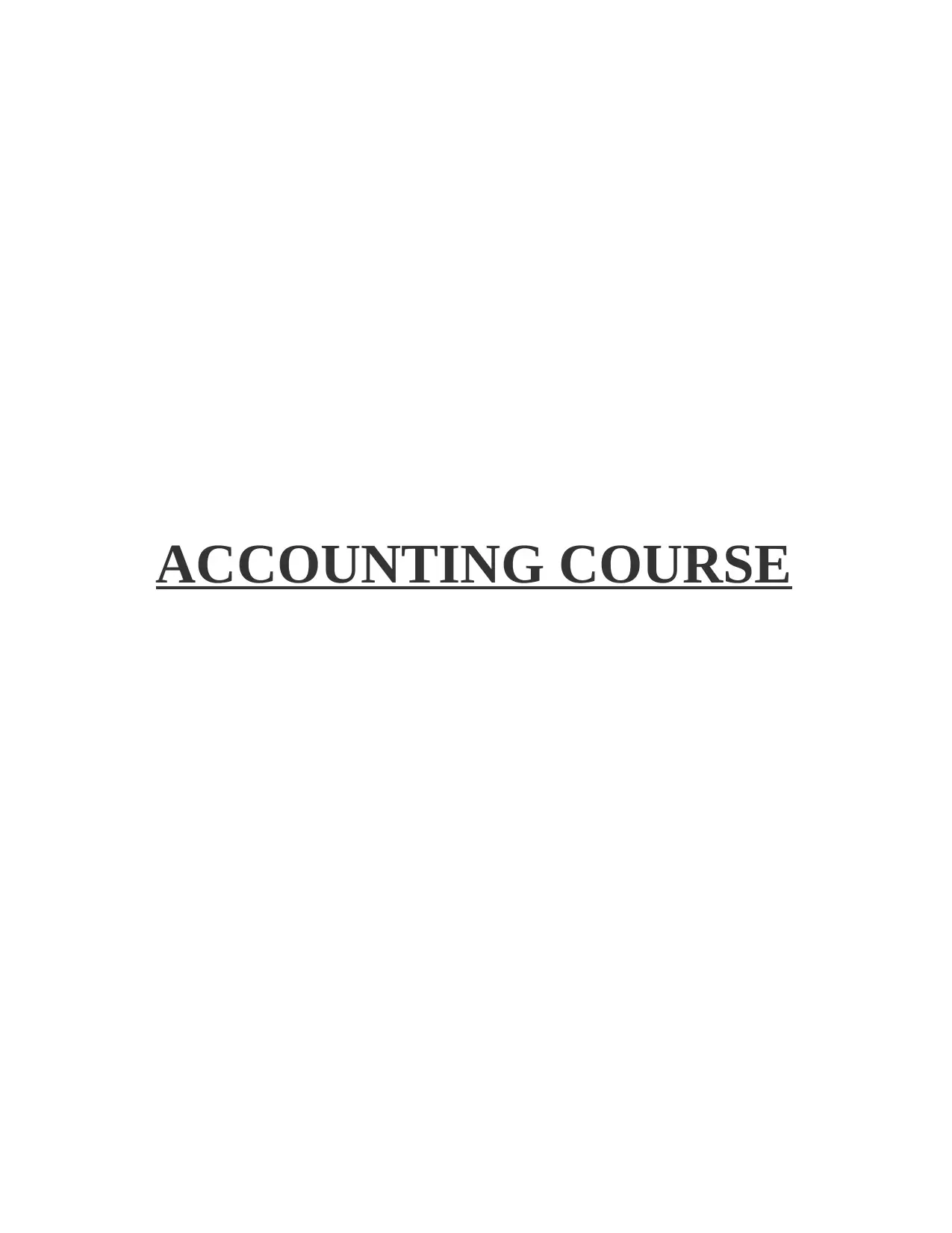
ACCOUNTING COURSE
Paraphrase This Document
Need a fresh take? Get an instant paraphrase of this document with our AI Paraphraser

MAIN BODY
Question 1
A. (I) Journal
Date Particular Debit $ Credit $
October 1' 2016 Cash Account
To Capital Account
(Being business started with cash)
$800000
$800000
October 2' 2016 Purchase Account
To Cash Account
(Being goods purchased for cash)
$3000
$3000
October 15'2016 Cash Account
To Sales Account
(Being sales made for cash)
$25000
$25000
October 18'2016 Stationeries Account
To Cash Account
(Being stationeries purchased)
$4000
$4000
October 23'2016 Furniture Account
To Cash Account
(Being furniture purchased for business)
$24000
$24000
October 25'2016 Electricity charges Account
To Cash Account
(Being electricity charges paid)
$3000
$3000
October 26'2016 Salary Account
To Cash Account
(Being salary paid)
$18000
$18000
October 28'2016 Rent Account $500
Question 1
A. (I) Journal
Date Particular Debit $ Credit $
October 1' 2016 Cash Account
To Capital Account
(Being business started with cash)
$800000
$800000
October 2' 2016 Purchase Account
To Cash Account
(Being goods purchased for cash)
$3000
$3000
October 15'2016 Cash Account
To Sales Account
(Being sales made for cash)
$25000
$25000
October 18'2016 Stationeries Account
To Cash Account
(Being stationeries purchased)
$4000
$4000
October 23'2016 Furniture Account
To Cash Account
(Being furniture purchased for business)
$24000
$24000
October 25'2016 Electricity charges Account
To Cash Account
(Being electricity charges paid)
$3000
$3000
October 26'2016 Salary Account
To Cash Account
(Being salary paid)
$18000
$18000
October 28'2016 Rent Account $500
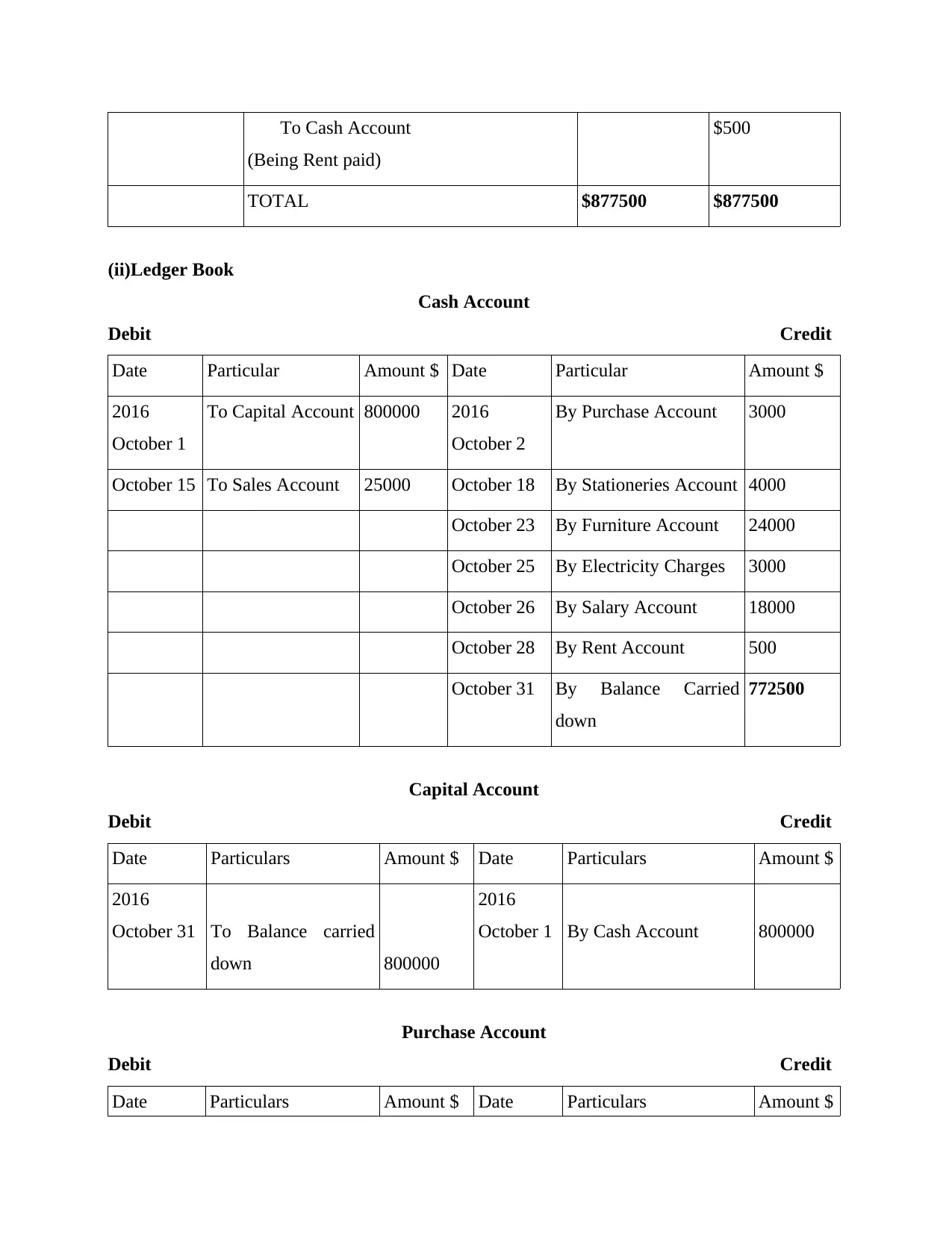
To Cash Account
(Being Rent paid)
$500
TOTAL $877500 $877500
(ii)Ledger Book
Cash Account
Debit Credit
Date Particular Amount $ Date Particular Amount $
2016
October 1
To Capital Account 800000 2016
October 2
By Purchase Account 3000
October 15 To Sales Account 25000 October 18 By Stationeries Account 4000
October 23 By Furniture Account 24000
October 25 By Electricity Charges 3000
October 26 By Salary Account 18000
October 28 By Rent Account 500
October 31 By Balance Carried
down
772500
Capital Account
Debit Credit
Date Particulars Amount $ Date Particulars Amount $
2016
October 31 To Balance carried
down 800000
2016
October 1 By Cash Account 800000
Purchase Account
Debit Credit
Date Particulars Amount $ Date Particulars Amount $
(Being Rent paid)
$500
TOTAL $877500 $877500
(ii)Ledger Book
Cash Account
Debit Credit
Date Particular Amount $ Date Particular Amount $
2016
October 1
To Capital Account 800000 2016
October 2
By Purchase Account 3000
October 15 To Sales Account 25000 October 18 By Stationeries Account 4000
October 23 By Furniture Account 24000
October 25 By Electricity Charges 3000
October 26 By Salary Account 18000
October 28 By Rent Account 500
October 31 By Balance Carried
down
772500
Capital Account
Debit Credit
Date Particulars Amount $ Date Particulars Amount $
2016
October 31 To Balance carried
down 800000
2016
October 1 By Cash Account 800000
Purchase Account
Debit Credit
Date Particulars Amount $ Date Particulars Amount $
⊘ This is a preview!⊘
Do you want full access?
Subscribe today to unlock all pages.

Trusted by 1+ million students worldwide

2016
October 2 To Cash Account 3000
2016
October31 By Balance carry down 3000
Sales Account
Debit Credit
Date Particulars Amount $ Date Particulars Amount $
2016
October 31 To Balance carry
down 25000
2016
October15 By Cash Account 25000
Stationeries Account
Dr Cr
Date Particulars Amount $ Date Particulars Amount $
2016
October 18 To Cash Account 4000
2016
October31 By Balance carry down 4000
Furniture Account
Dr Cr
Date Particulars Amount $ Date Particulars Amount $
2016
October 23 To Cash Account 24000
2016
October31 By Balance carry down 24000
Electricity Charges Account
October 2 To Cash Account 3000
2016
October31 By Balance carry down 3000
Sales Account
Debit Credit
Date Particulars Amount $ Date Particulars Amount $
2016
October 31 To Balance carry
down 25000
2016
October15 By Cash Account 25000
Stationeries Account
Dr Cr
Date Particulars Amount $ Date Particulars Amount $
2016
October 18 To Cash Account 4000
2016
October31 By Balance carry down 4000
Furniture Account
Dr Cr
Date Particulars Amount $ Date Particulars Amount $
2016
October 23 To Cash Account 24000
2016
October31 By Balance carry down 24000
Electricity Charges Account
Paraphrase This Document
Need a fresh take? Get an instant paraphrase of this document with our AI Paraphraser

Dr Cr
Date Particulars Amount $ Date Particulars Amount $
2016
October 25 To Cash Account 3000
2016
October31 By Balance carry down 3000
Salary Account
Dr Cr
Date Particulars Amount $ Date Particulars Amount $
2016
October 26 To Cash Account 18000
2016
October31 By Balance carry down 18000
Rent Account
Dr Cr
Date Particulars Amount $ Date Particulars Amount $
2016
October 28 To Cash Account 500
2016
October31 By Balance Carry down 500
B. Bookkeeping refers to the process of recording the transaction and maintaining books of
accounts in a required manner so that the information can be made available any time when need
arises. It records transaction in date-wise manner. Bookkeeping ends here itself by just recording
the business transactions but accounting is quite broader and involves lengthy process whereby
the process involves recording, maintaining, analysing, summarizing, interpreting and
communicating the final results to parties interested in it (King, 2018). Bookkeeping and
accounting are related to each other but not similar because bookkeeping is one part of
accounting whereas accounting is a very wider concept (Andreica, 2016).
King, R., 2018. Quickbooks: The complete guide to Quickbooks for beginners, including
bookkeeping and accounting basics. CreateSpace Independent Publishing Platform.
Date Particulars Amount $ Date Particulars Amount $
2016
October 25 To Cash Account 3000
2016
October31 By Balance carry down 3000
Salary Account
Dr Cr
Date Particulars Amount $ Date Particulars Amount $
2016
October 26 To Cash Account 18000
2016
October31 By Balance carry down 18000
Rent Account
Dr Cr
Date Particulars Amount $ Date Particulars Amount $
2016
October 28 To Cash Account 500
2016
October31 By Balance Carry down 500
B. Bookkeeping refers to the process of recording the transaction and maintaining books of
accounts in a required manner so that the information can be made available any time when need
arises. It records transaction in date-wise manner. Bookkeeping ends here itself by just recording
the business transactions but accounting is quite broader and involves lengthy process whereby
the process involves recording, maintaining, analysing, summarizing, interpreting and
communicating the final results to parties interested in it (King, 2018). Bookkeeping and
accounting are related to each other but not similar because bookkeeping is one part of
accounting whereas accounting is a very wider concept (Andreica, 2016).
King, R., 2018. Quickbooks: The complete guide to Quickbooks for beginners, including
bookkeeping and accounting basics. CreateSpace Independent Publishing Platform.
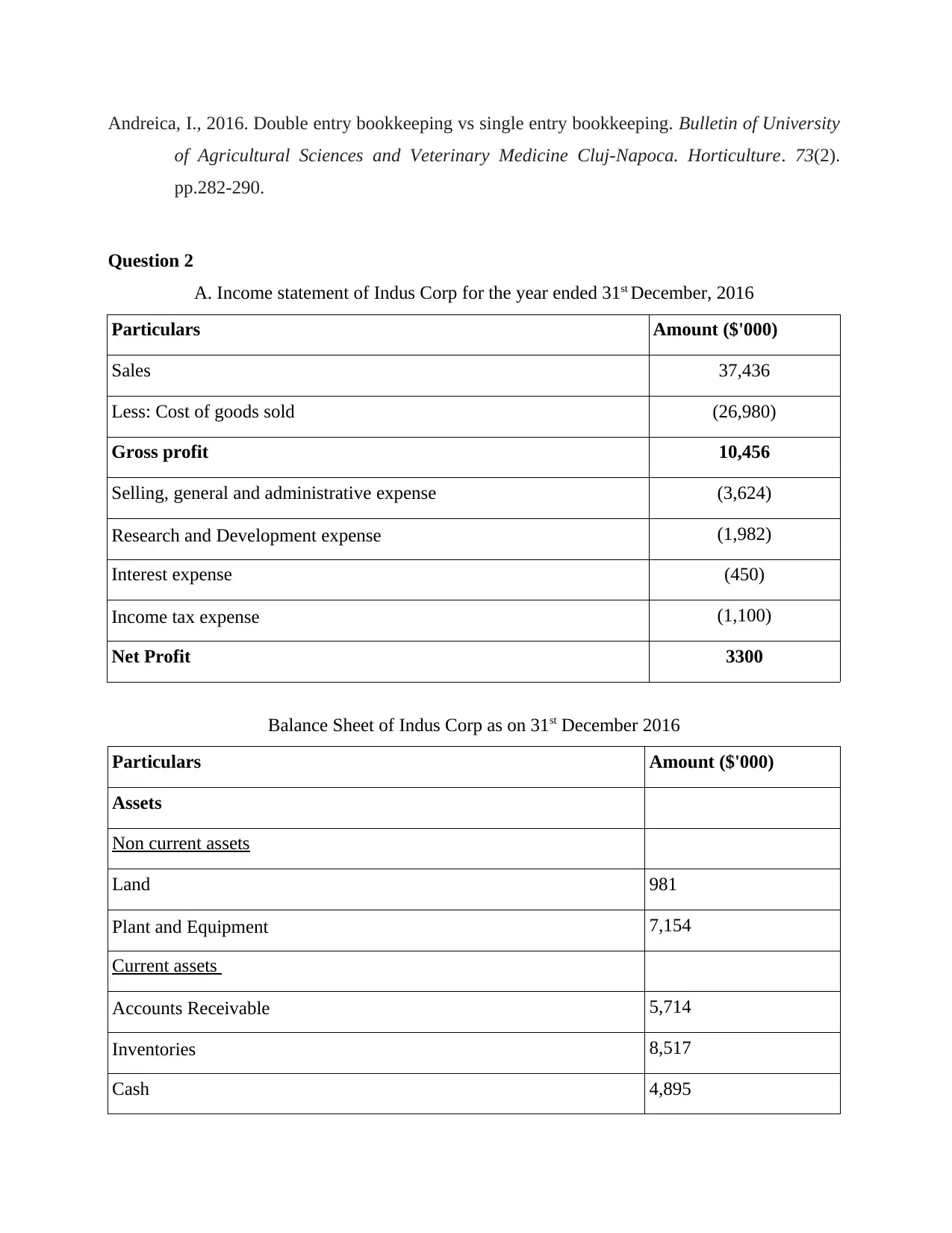
Andreica, I., 2016. Double entry bookkeeping vs single entry bookkeeping. Bulletin of University
of Agricultural Sciences and Veterinary Medicine Cluj-Napoca. Horticulture. 73(2).
pp.282-290.
Question 2
A. Income statement of Indus Corp for the year ended 31st December, 2016
Particulars Amount ($'000)
Sales 37,436
Less: Cost of goods sold (26,980)
Gross profit 10,456
Selling, general and administrative expense (3,624)
Research and Development expense (1,982)
Interest expense (450)
Income tax expense (1,100)
Net Profit 3300
Balance Sheet of Indus Corp as on 31st December 2016
Particulars Amount ($'000)
Assets
Non current assets
Land 981
Plant and Equipment 7,154
Current assets
Accounts Receivable 5,714
Inventories 8,517
Cash 4,895
of Agricultural Sciences and Veterinary Medicine Cluj-Napoca. Horticulture. 73(2).
pp.282-290.
Question 2
A. Income statement of Indus Corp for the year ended 31st December, 2016
Particulars Amount ($'000)
Sales 37,436
Less: Cost of goods sold (26,980)
Gross profit 10,456
Selling, general and administrative expense (3,624)
Research and Development expense (1,982)
Interest expense (450)
Income tax expense (1,100)
Net Profit 3300
Balance Sheet of Indus Corp as on 31st December 2016
Particulars Amount ($'000)
Assets
Non current assets
Land 981
Plant and Equipment 7,154
Current assets
Accounts Receivable 5,714
Inventories 8,517
Cash 4,895
⊘ This is a preview!⊘
Do you want full access?
Subscribe today to unlock all pages.

Trusted by 1+ million students worldwide
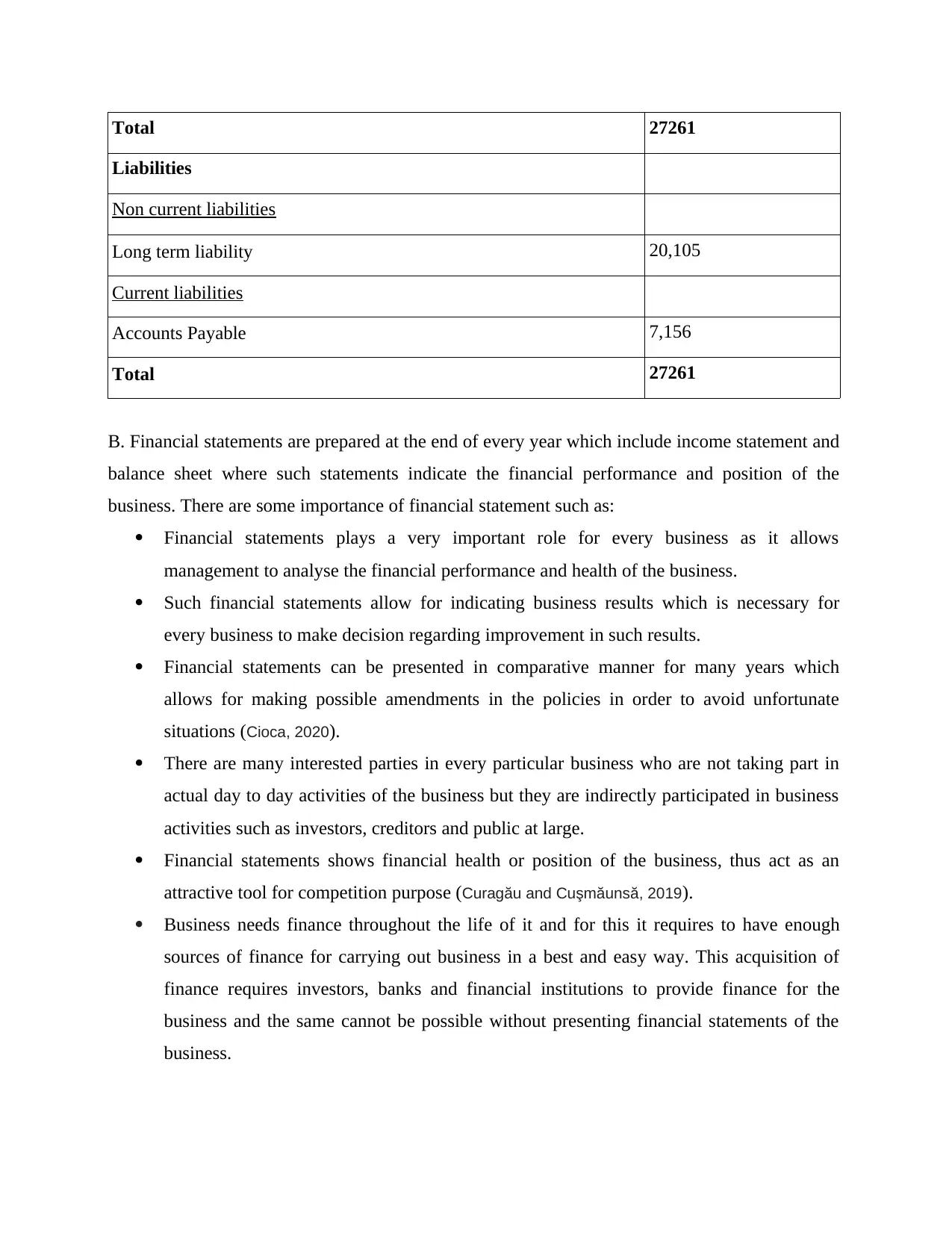
Total 27261
Liabilities
Non current liabilities
Long term liability 20,105
Current liabilities
Accounts Payable 7,156
Total 27261
B. Financial statements are prepared at the end of every year which include income statement and
balance sheet where such statements indicate the financial performance and position of the
business. There are some importance of financial statement such as:
Financial statements plays a very important role for every business as it allows
management to analyse the financial performance and health of the business.
Such financial statements allow for indicating business results which is necessary for
every business to make decision regarding improvement in such results.
Financial statements can be presented in comparative manner for many years which
allows for making possible amendments in the policies in order to avoid unfortunate
situations (Cioca, 2020).
There are many interested parties in every particular business who are not taking part in
actual day to day activities of the business but they are indirectly participated in business
activities such as investors, creditors and public at large.
Financial statements shows financial health or position of the business, thus act as an
attractive tool for competition purpose (Curagău and Cuşmăunsă, 2019).
Business needs finance throughout the life of it and for this it requires to have enough
sources of finance for carrying out business in a best and easy way. This acquisition of
finance requires investors, banks and financial institutions to provide finance for the
business and the same cannot be possible without presenting financial statements of the
business.
Liabilities
Non current liabilities
Long term liability 20,105
Current liabilities
Accounts Payable 7,156
Total 27261
B. Financial statements are prepared at the end of every year which include income statement and
balance sheet where such statements indicate the financial performance and position of the
business. There are some importance of financial statement such as:
Financial statements plays a very important role for every business as it allows
management to analyse the financial performance and health of the business.
Such financial statements allow for indicating business results which is necessary for
every business to make decision regarding improvement in such results.
Financial statements can be presented in comparative manner for many years which
allows for making possible amendments in the policies in order to avoid unfortunate
situations (Cioca, 2020).
There are many interested parties in every particular business who are not taking part in
actual day to day activities of the business but they are indirectly participated in business
activities such as investors, creditors and public at large.
Financial statements shows financial health or position of the business, thus act as an
attractive tool for competition purpose (Curagău and Cuşmăunsă, 2019).
Business needs finance throughout the life of it and for this it requires to have enough
sources of finance for carrying out business in a best and easy way. This acquisition of
finance requires investors, banks and financial institutions to provide finance for the
business and the same cannot be possible without presenting financial statements of the
business.
Paraphrase This Document
Need a fresh take? Get an instant paraphrase of this document with our AI Paraphraser
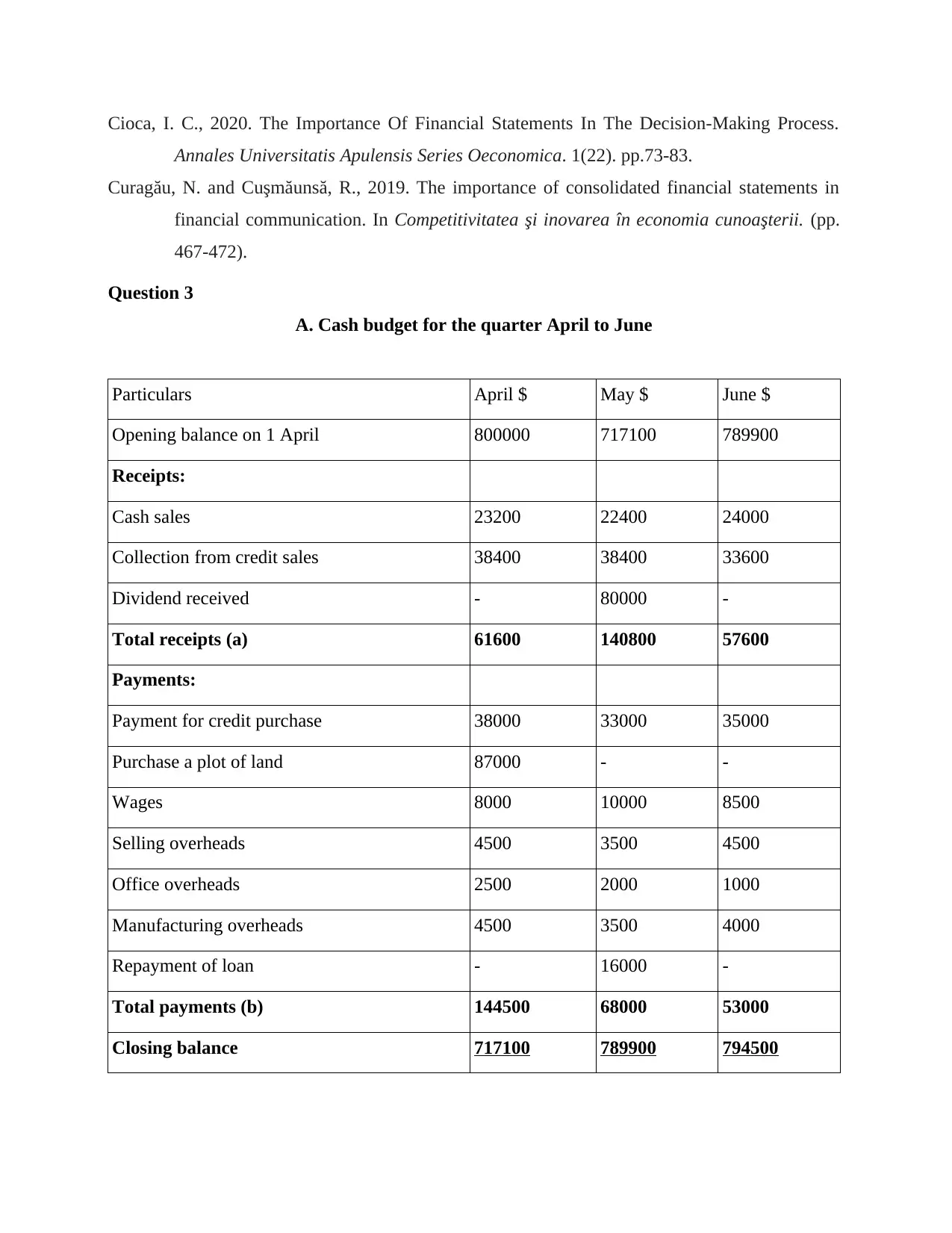
Cioca, I. C., 2020. The Importance Of Financial Statements In The Decision-Making Process.
Annales Universitatis Apulensis Series Oeconomica. 1(22). pp.73-83.
Curagău, N. and Cuşmăunsă, R., 2019. The importance of consolidated financial statements in
financial communication. In Competitivitatea şi inovarea în economia cunoaşterii. (pp.
467-472).
Question 3
A. Cash budget for the quarter April to June
Particulars April $ May $ June $
Opening balance on 1 April 800000 717100 789900
Receipts:
Cash sales 23200 22400 24000
Collection from credit sales 38400 38400 33600
Dividend received - 80000 -
Total receipts (a) 61600 140800 57600
Payments:
Payment for credit purchase 38000 33000 35000
Purchase a plot of land 87000 - -
Wages 8000 10000 8500
Selling overheads 4500 3500 4500
Office overheads 2500 2000 1000
Manufacturing overheads 4500 3500 4000
Repayment of loan - 16000 -
Total payments (b) 144500 68000 53000
Closing balance 717100 789900 794500
Annales Universitatis Apulensis Series Oeconomica. 1(22). pp.73-83.
Curagău, N. and Cuşmăunsă, R., 2019. The importance of consolidated financial statements in
financial communication. In Competitivitatea şi inovarea în economia cunoaşterii. (pp.
467-472).
Question 3
A. Cash budget for the quarter April to June
Particulars April $ May $ June $
Opening balance on 1 April 800000 717100 789900
Receipts:
Cash sales 23200 22400 24000
Collection from credit sales 38400 38400 33600
Dividend received - 80000 -
Total receipts (a) 61600 140800 57600
Payments:
Payment for credit purchase 38000 33000 35000
Purchase a plot of land 87000 - -
Wages 8000 10000 8500
Selling overheads 4500 3500 4500
Office overheads 2500 2000 1000
Manufacturing overheads 4500 3500 4000
Repayment of loan - 16000 -
Total payments (b) 144500 68000 53000
Closing balance 717100 789900 794500
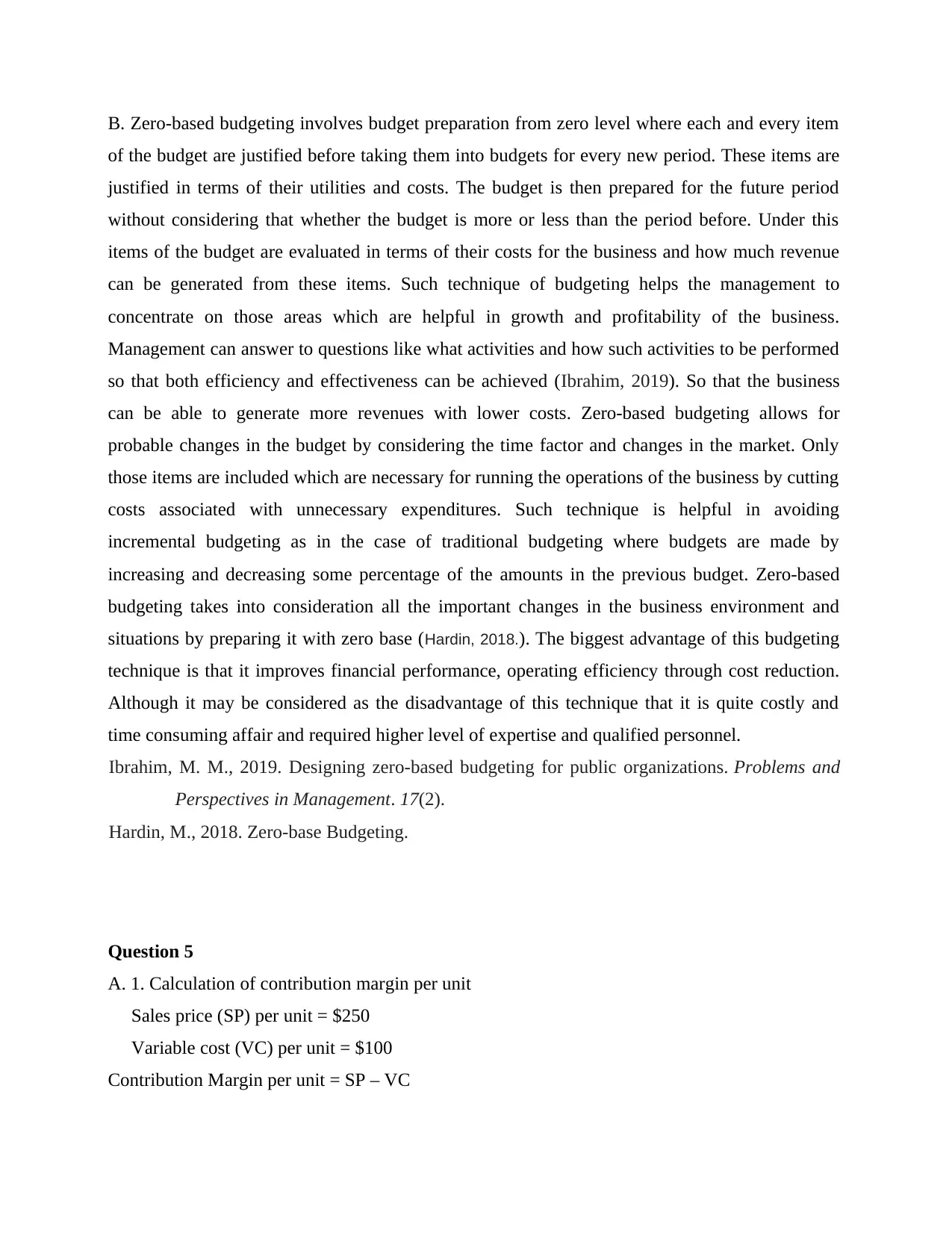
B. Zero-based budgeting involves budget preparation from zero level where each and every item
of the budget are justified before taking them into budgets for every new period. These items are
justified in terms of their utilities and costs. The budget is then prepared for the future period
without considering that whether the budget is more or less than the period before. Under this
items of the budget are evaluated in terms of their costs for the business and how much revenue
can be generated from these items. Such technique of budgeting helps the management to
concentrate on those areas which are helpful in growth and profitability of the business.
Management can answer to questions like what activities and how such activities to be performed
so that both efficiency and effectiveness can be achieved (Ibrahim, 2019). So that the business
can be able to generate more revenues with lower costs. Zero-based budgeting allows for
probable changes in the budget by considering the time factor and changes in the market. Only
those items are included which are necessary for running the operations of the business by cutting
costs associated with unnecessary expenditures. Such technique is helpful in avoiding
incremental budgeting as in the case of traditional budgeting where budgets are made by
increasing and decreasing some percentage of the amounts in the previous budget. Zero-based
budgeting takes into consideration all the important changes in the business environment and
situations by preparing it with zero base (Hardin, 2018.). The biggest advantage of this budgeting
technique is that it improves financial performance, operating efficiency through cost reduction.
Although it may be considered as the disadvantage of this technique that it is quite costly and
time consuming affair and required higher level of expertise and qualified personnel.
Ibrahim, M. M., 2019. Designing zero-based budgeting for public organizations. Problems and
Perspectives in Management. 17(2).
Hardin, M., 2018. Zero-base Budgeting.
Question 5
A. 1. Calculation of contribution margin per unit
Sales price (SP) per unit = $250
Variable cost (VC) per unit = $100
Contribution Margin per unit = SP – VC
of the budget are justified before taking them into budgets for every new period. These items are
justified in terms of their utilities and costs. The budget is then prepared for the future period
without considering that whether the budget is more or less than the period before. Under this
items of the budget are evaluated in terms of their costs for the business and how much revenue
can be generated from these items. Such technique of budgeting helps the management to
concentrate on those areas which are helpful in growth and profitability of the business.
Management can answer to questions like what activities and how such activities to be performed
so that both efficiency and effectiveness can be achieved (Ibrahim, 2019). So that the business
can be able to generate more revenues with lower costs. Zero-based budgeting allows for
probable changes in the budget by considering the time factor and changes in the market. Only
those items are included which are necessary for running the operations of the business by cutting
costs associated with unnecessary expenditures. Such technique is helpful in avoiding
incremental budgeting as in the case of traditional budgeting where budgets are made by
increasing and decreasing some percentage of the amounts in the previous budget. Zero-based
budgeting takes into consideration all the important changes in the business environment and
situations by preparing it with zero base (Hardin, 2018.). The biggest advantage of this budgeting
technique is that it improves financial performance, operating efficiency through cost reduction.
Although it may be considered as the disadvantage of this technique that it is quite costly and
time consuming affair and required higher level of expertise and qualified personnel.
Ibrahim, M. M., 2019. Designing zero-based budgeting for public organizations. Problems and
Perspectives in Management. 17(2).
Hardin, M., 2018. Zero-base Budgeting.
Question 5
A. 1. Calculation of contribution margin per unit
Sales price (SP) per unit = $250
Variable cost (VC) per unit = $100
Contribution Margin per unit = SP – VC
⊘ This is a preview!⊘
Do you want full access?
Subscribe today to unlock all pages.

Trusted by 1+ million students worldwide
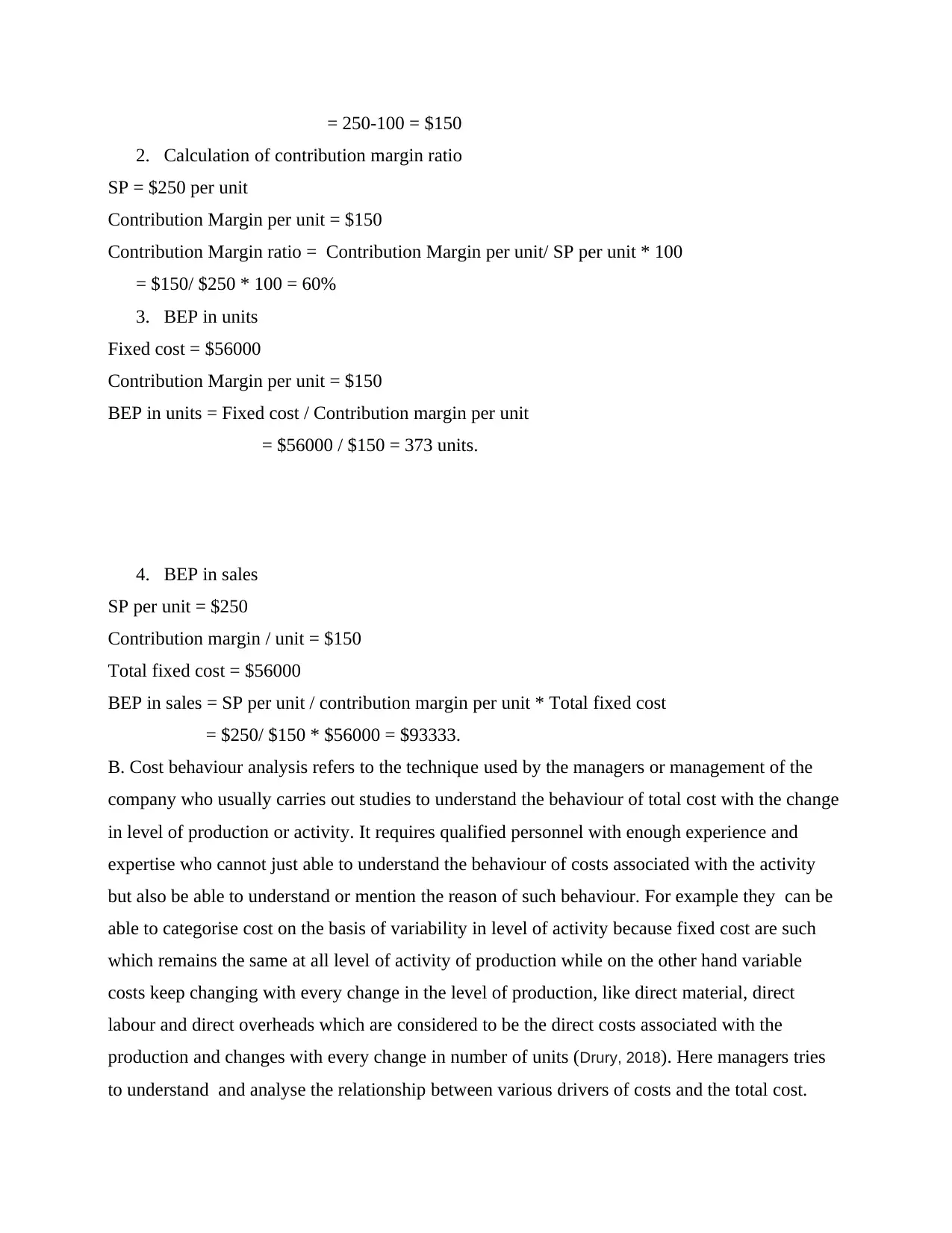
= 250-100 = $150
2. Calculation of contribution margin ratio
SP = $250 per unit
Contribution Margin per unit = $150
Contribution Margin ratio = Contribution Margin per unit/ SP per unit * 100
= $150/ $250 * 100 = 60%
3. BEP in units
Fixed cost = $56000
Contribution Margin per unit = $150
BEP in units = Fixed cost / Contribution margin per unit
= $56000 / $150 = 373 units.
4. BEP in sales
SP per unit = $250
Contribution margin / unit = $150
Total fixed cost = $56000
BEP in sales = SP per unit / contribution margin per unit * Total fixed cost
= $250/ $150 * $56000 = $93333.
B. Cost behaviour analysis refers to the technique used by the managers or management of the
company who usually carries out studies to understand the behaviour of total cost with the change
in level of production or activity. It requires qualified personnel with enough experience and
expertise who cannot just able to understand the behaviour of costs associated with the activity
but also be able to understand or mention the reason of such behaviour. For example they can be
able to categorise cost on the basis of variability in level of activity because fixed cost are such
which remains the same at all level of activity of production while on the other hand variable
costs keep changing with every change in the level of production, like direct material, direct
labour and direct overheads which are considered to be the direct costs associated with the
production and changes with every change in number of units (Drury, 2018). Here managers tries
to understand and analyse the relationship between various drivers of costs and the total cost.
2. Calculation of contribution margin ratio
SP = $250 per unit
Contribution Margin per unit = $150
Contribution Margin ratio = Contribution Margin per unit/ SP per unit * 100
= $150/ $250 * 100 = 60%
3. BEP in units
Fixed cost = $56000
Contribution Margin per unit = $150
BEP in units = Fixed cost / Contribution margin per unit
= $56000 / $150 = 373 units.
4. BEP in sales
SP per unit = $250
Contribution margin / unit = $150
Total fixed cost = $56000
BEP in sales = SP per unit / contribution margin per unit * Total fixed cost
= $250/ $150 * $56000 = $93333.
B. Cost behaviour analysis refers to the technique used by the managers or management of the
company who usually carries out studies to understand the behaviour of total cost with the change
in level of production or activity. It requires qualified personnel with enough experience and
expertise who cannot just able to understand the behaviour of costs associated with the activity
but also be able to understand or mention the reason of such behaviour. For example they can be
able to categorise cost on the basis of variability in level of activity because fixed cost are such
which remains the same at all level of activity of production while on the other hand variable
costs keep changing with every change in the level of production, like direct material, direct
labour and direct overheads which are considered to be the direct costs associated with the
production and changes with every change in number of units (Drury, 2018). Here managers tries
to understand and analyse the relationship between various drivers of costs and the total cost.
Paraphrase This Document
Need a fresh take? Get an instant paraphrase of this document with our AI Paraphraser

Managers get aids in understanding the areas which are causing the overall costs to be higher.
Manager can plan for further expansion through cost behaviour analysis. Cost behaviour analysis
also facilitates examination and effect of cost and volume on the profits of the company. It is
always helpful in carrying out better planning and controlling in the business. Cost behaviour can
be categorised in three types, that is fixed, variable and semi variable which behaves differently
with the change in business level of activity (Azeez, DongPing and Mahmood, 2018). At last, cost
behaviour analysis is considered to be the most important study in accounting for achieving
operating efficiency and improving profitability of the business but it requires manager's ability
too towards application of such conceptual behaviour in the real world business arena which
behaves quite differently.
Drury, C., 2018. Cost and management accounting. Cengage Learning.
Azeez, K. A., DongPing, H. and Mahmood, M. A., 2018. Capacity expansion decisions into
asymmetric cost behaviour: reviews and search for new determinants. International
Journal of Services Operations and Informatics. 9(2). pp.139-159.
Manager can plan for further expansion through cost behaviour analysis. Cost behaviour analysis
also facilitates examination and effect of cost and volume on the profits of the company. It is
always helpful in carrying out better planning and controlling in the business. Cost behaviour can
be categorised in three types, that is fixed, variable and semi variable which behaves differently
with the change in business level of activity (Azeez, DongPing and Mahmood, 2018). At last, cost
behaviour analysis is considered to be the most important study in accounting for achieving
operating efficiency and improving profitability of the business but it requires manager's ability
too towards application of such conceptual behaviour in the real world business arena which
behaves quite differently.
Drury, C., 2018. Cost and management accounting. Cengage Learning.
Azeez, K. A., DongPing, H. and Mahmood, M. A., 2018. Capacity expansion decisions into
asymmetric cost behaviour: reviews and search for new determinants. International
Journal of Services Operations and Informatics. 9(2). pp.139-159.

QUESTION 6
A. Calculation of EOQ for APEX Inc.
Annual Demand (A) = 90000 units
Cost of placing order (O) = $30
Carrying cost per unit (C)= $9
EOQ = sqrt(2* A* O)/ C
= sqrt (2 * 90000 * 30) / 9
= sqrt (5400000) / 9
= sqrt 600000
= 774 units.
B. Calculation of average inventory when safety stock is 2000 units
Average inventory = EOQ / 2 + Safety Stock (SS)
= 774 / 2 + 2000
= 387 + 2000 = 2387 units.
C. Maintaining Inventory records, physical counting of goods and chances of occurring errors
Physical recording method of stock valuation is a prominent approach to record the stock
in company's books of accounts. Under this approach physical calculation and valuation is done
over the stock available in the company's warehouse in the end of the financial year. Physical
verification and valuation is done by the employee delegated the respective position in the stock
department of company. Physical counting is an effective approach as it also help to resist the
corruption in the stock counting (Adamska and Szewczuk-Stepien, 2020). This method of stock
valuation improve authenticity in the overall value of stock. Along with all the advantage this
method also lead to error in physical counting of number of units available in stock. Many times'
employee do not get to focus over the work that also lead to wrong counting and valuation of
stock. Many times errors are done due top motive of the employee and also many times it also
entertains without any motive (Rossi, Pozzi and Testa, 2017). Many times in order to improve the
value of closing stock management might intervene in the overall counting of stock. This
unethical practice might mislead the overall results against the stock valuation method.
A. Calculation of EOQ for APEX Inc.
Annual Demand (A) = 90000 units
Cost of placing order (O) = $30
Carrying cost per unit (C)= $9
EOQ = sqrt(2* A* O)/ C
= sqrt (2 * 90000 * 30) / 9
= sqrt (5400000) / 9
= sqrt 600000
= 774 units.
B. Calculation of average inventory when safety stock is 2000 units
Average inventory = EOQ / 2 + Safety Stock (SS)
= 774 / 2 + 2000
= 387 + 2000 = 2387 units.
C. Maintaining Inventory records, physical counting of goods and chances of occurring errors
Physical recording method of stock valuation is a prominent approach to record the stock
in company's books of accounts. Under this approach physical calculation and valuation is done
over the stock available in the company's warehouse in the end of the financial year. Physical
verification and valuation is done by the employee delegated the respective position in the stock
department of company. Physical counting is an effective approach as it also help to resist the
corruption in the stock counting (Adamska and Szewczuk-Stepien, 2020). This method of stock
valuation improve authenticity in the overall value of stock. Along with all the advantage this
method also lead to error in physical counting of number of units available in stock. Many times'
employee do not get to focus over the work that also lead to wrong counting and valuation of
stock. Many times errors are done due top motive of the employee and also many times it also
entertains without any motive (Rossi, Pozzi and Testa, 2017). Many times in order to improve the
value of closing stock management might intervene in the overall counting of stock. This
unethical practice might mislead the overall results against the stock valuation method.
⊘ This is a preview!⊘
Do you want full access?
Subscribe today to unlock all pages.

Trusted by 1+ million students worldwide
1 out of 14
Related Documents
Your All-in-One AI-Powered Toolkit for Academic Success.
+13062052269
info@desklib.com
Available 24*7 on WhatsApp / Email
![[object Object]](/_next/static/media/star-bottom.7253800d.svg)
Unlock your academic potential
Copyright © 2020–2025 A2Z Services. All Rights Reserved. Developed and managed by ZUCOL.




